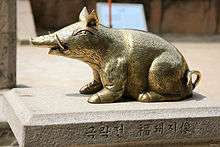Pig (zodiac)
The Pig (豬) is the twelfth of the 12-year cycle of animals which appear in Chinese zodiac, in relation to the Chinese calendar and system of horology, and paralleling the system of ten Heavenly Stems and twelve Earthly Branches. Although the term "zodiac" (etymologically referring to a "[circle of] little animals") is used in the phrase "Chinese zodiac", there is a major difference between the Chinese usage and Western astrology: the zodiacal animals (including the zodiacal Pig) do not relate to the zodiac as the area of the sky that extends approximately 8° north or south (as measured in celestial latitude) of the ecliptic, the apparent path of the Sun, the Moon, and visible planets across the celestial sphere's constellations, over the course of the year.


In Chinese astrology, "zodiacal" animals refer to fixed cycles of twelve animals. The same cycle of twelve is used for cycles of years and cycles of hours. In the case of years, the cycle of twelve corresponds to the twelve-year cycle of Jupiter. In the case of the hours, the twelve hours represent twelve double-hours for each period of night and day. In the continuous sexagenary cycle of sixty years, every twelfth year corresponds to hai, 亥 (the twelfth of the twelve Earthly Branches); this re-recurring twelfth year is commonly called the Year of the Pig (豬年).
There are five types of Pigs, named after the Chinese elements. In order, they are: Metal, Water, Wood, Fire, and Earth. These correspond to the Heavenly Stems. Thus, there are five pig years in every sexegenary cycle. For example, in the year 2019, the Earthly Branch is the twelfth, hài, and the Heavenly Stem is the sixth, jǐ 己. The Chinese New Year in 2019 is February fifth: this corresponds with the beginning of both the sexegenary year of jǐ hài and also the zodiac year of the Earth Pig.
In the Japanese zodiac[1] and the Tibetan zodiac,[2] the Pig is replaced by the boar. In the Dai zodiac, the Pig is replaced by the elephant.[3] In the Gurung zodiac, the Pig is replaced by the deer.[4]
Pig in the Chinese zodiac legend
According to the myths, the Pig was the last to arrive when the Jade Emperor called for the great meeting. Other sources said that Buddha called for a great meeting when he was about to leave the Earth. The Pig came in last.
Legend has it that just as the emperor was about to call it a day, an oink and squeal was heard from a little Pig. The term "lazy Pig" is due here as the Pig got hungry during the race, promptly stopped for a feast then fell asleep. After the nap, the Pig continued the race and was named the 12th and last animal of the zodiac cycle.[5]
Other sources say that given his very stout form, he was just too slow a swimmer, and thus he could not do anything against the other animals, or it was too fast that he went up the wrong side of the river first.
Years and the Five Elements

The Pig and the Elements
The natural element of the Pig is Water. Thus, it is commonly associated with emotions and intuitions. Yet, given that along with the elements (called the Celestial stem), the animal zodiac (called the Earthly stem) also follows a cycle, each of the elements affect the characteristic of the same Earthly stem (see Sexagenary cycle).
However, the Pig is yin, and thus only the negative aspects of the elements can be attached to them, thus only 5 kinds of Pigs are found in the zodiac. They are the following:
The Years of the Pig
People born within these date ranges can be said to have been born in the "Year of the Pig", while bearing the following elemental sign:
| Start date | End date | Heavenly Branch |
|---|---|---|
| 10 February 1899 | 31 January 1900 | Earth Pig |
| 30 January 1911 | 18 February 1912 | Metal Pig |
| 16 February 1923 | 5 February 1924 | Water Pig |
| 4 February 1935 | 24 January 1936 | Wood Pig |
| 22 January 1947 | 10 February 1948 | Fire Pig |
| 8 February 1959 | 28 January 1960 | Earth Pig |
| 27 January 1971 | 15 February 1972 | Metal Pig |
| 13 February 1983 | 2 February 1984 | Water Pig |
| 31 January 1995 | 19 February 1996 | Wood Pig |
| 18 February 2007 | 7 February 2008 | Fire Pig |
| 5 February 2019 | 25 January 2020 | Earth Pig |
| 23 January 2031 | 11 February 2032 | Metal Pig |
| 10 February 2043 | 30 January 2044 | Water Pig |
| 28 January 2055 | 15 February 2056 | Wood Pig |
| 14 February 2067 | 3 February 2068 | Fire Pig |
| 2 February 2079 | 25 January 2080 | Earth Pig |
| 18 February 2091 | 7 February 2092 | Metal Pig |
| 4 February 2103 | 28 January 2104 | Water Pig |
Hour of the Pig
Similarly to the usage of the traditional Japanese clock, each hour of a day-night period was divided into 12 double-hours, each of which corresponding with one of the twelve signs of the Chinese zodiac, with similar symbolic motif and astrological significance. The first of the twelve double hours (the Hour of the Rat) encompasses midnight, at the middle of the double hour, corresponding with 11:00 p.m. to 1:00 p.m., with midnight being the midpoint of the first double-hour. The animals in the hourly sequence are the same and in the same order as in the yearly sequence. The Pig is the last in the sequence, with the Hour of the Pig corresponding to the double-hour 9:00 p.m. to 11:00 p.m., also known as the hour hai (亥). [6]
Given that the traditional Chinese day-night cycle was composed of 12 hours, each sign is given to the different signs of the zodiac. The Pig is assigned to govern the time between 21:00 hrs to 22:59 hrs. According to tradition, this is the time when the Pig is doing what it does best (sleeping and enjoying the sweet life).
In terms of astrology, the hours in which people were born (technically termed as the Ascendant) are the second most important facet of their astrology. Thus, this alters greatly the characteristics. Even if people were born in any year governed by another animal (for example, anyone born on 20 December 2000, i.e. year of the Dragon) will display strong characteristics of the Pig. Thus, they may be fierce and strong like the Dragon, but at the same time emotional and intuitive like the Pig.
Compatibility
| Sign | Best Match | Average | No Match |
| Pig | Pig, Rabbit, Goat | Dog, Tiger, Horse, Dragon, Monkey, Rat, Rooster, Ox | Snake |
Relationship with other signs
The Pig belongs to the fourth Trine of the Chinese zodiac. It is most compatible with the Rabbit. The gentle and sensitive Goat is most compatible with the Pig. Two Pigs can get along well with each other. It is said that the relationship between these three archetypes work best as they strive for aestheticism, beauty, and a more philosophical, and intellectual approach in life. Their calm nature gives them great leadership abilities.
They are artistic, refined, intuitive, intelligent, and well-mannered. These souls love the preliminaries in love, and are fine artists in their lovemaking. The Rabbit, Goat, and Pig have been bestowed with calmer natures than the other nine signs.
These three are compassionately aware, yet detached and resigned to their condition. They seek beauty and a sensitive love. They are caring, unique, self-sacrificing, obliging, sensible, creative, empathetic, tactful, and prudent. They can also be naive, pedantic, insecure, cunning, indecisive, and pessimistic.
The Snake is said to be incompatible with the Pig, and is the opposite from that of the reserved and contemplative Snake.
Basic astrology elements
| Earthly Branches: | Hai |
| The Five Elements: | Water |
| Yin Yang: | Yin |
| Lunar Month: | Tenth |
| Lucky Numbers: | 2, 5, 6, 8; Avoid: 3, 4, 9 |
| Lucky Flowers: | lily |
| Lucky Colors: | yellow; Avoid: red, blue |
| Season: | Winter |
Cultural notes
Some Chinese Muslims will say that they were born in the year of the hai, 亥 (twelfth and final year of the zodiac) to avoid saying the "Pig".[7] This is because pigs are haram (forbidden to eat) in Islam and therefore Muslims consider pigs unclean.
Increasing numbers of countries and regions now issue lunar new year stamps. For the 2019 Year of the Pig, the USC U.S.-China Institute collected stamps from 56 jurisdictions.[8]
See also
- Chinese astrology
- Chinese calendar correspondence table
- Burmese zodiac
References
- "Japanese Zodiac Signs and Symbols". japanesezodiac.org/. 5 January 2012. Retrieved 1 January 2015.
- ricardobaddouh (28 January 2014). "Tibetan Astrology – Table of Year-Animal-Element". Retrieved 9 June 2017.
- "Chinese Zodiac". Warrior Tours. Retrieved 9 June 2017.
- "Tamu (Gurung) Losar Festival". ECS Nepal. 11 July 2010. Retrieved 9 June 2017.
- Audrey Lim (3 March 2003). "Legend of the Chinese Zodiac". ThingsAsian. Retrieved 9 June 2017.
-
- Palmer, Martin, editor, et al, (1986). T'ung Shu: The Ancient Chinese Almanac. Boston: Shambala. ISBN 0-394-74221-4, pp. 34-35
- Gillette, Maris Boyd (2002). Between Mecca And Beijing. Stanford: Stanford University Press. p. 124 – via Google Book Search.
- "Celebrating the Year of the Pig". USC U.S.-China Institute. 4 February 2019. Retrieved 7 February 2019.
Further reading
- Neil Somerville (2006). Your Chinese Horoscope 2007: What the Year of the Pig Holds for You. HarperCollins. pp. 384. ISBN 9780007211326.
- Neil Somerville (2012). The Pig in 2013: Your Chinese Horoscope. HarperCollins. p. 80. ISBN 9780007478651.
- Neil Somerville (2013). The Pig in 2014: Your Chinese Horoscope. HarperCollins. p. 320. ISBN 9780007537044.
- Neil Somerville (2015). The Pig in 2016: Your Chinese Horoscope. HarperCollins. p. 320. ISBN 9780008138189.
- Neil Somerville (2016). The Pig in 2017: Your Chinese Horoscope. HarperCollins. p. 52. ISBN 9780008205515.
| Wikimedia Commons has media related to Pig (zodiac). |